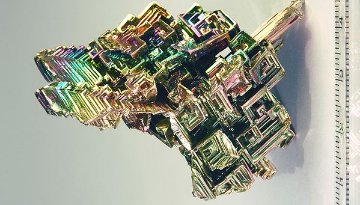
Bismuth
Bismuth General
| Name:Bismuth | Symbol:Bi |
| Type:Metal, Nitrogen group | Atomic weight:208.9804 |
| Density @ 293 K:9.807 g/cm3 | Atomic volume:21.3 cm3/mol |
|
Discovered:
Bismuth has been known since the fifteenth century. In 1753 Claude Geoffroy the Younger established that it differed from lead. |
|
Bismuth States
| State (s, l, g):solid | |
| Melting point:544.5 K (271.4 °C) | Boiling point:1837 K (1564 °C) |
Bismuth Energies
| Specific heat capacity:0.123 J g-1 K-1 | Heat of atomization:207 kJ mol-1 |
| Heat of fusion: 11.3 kJ mol-1 | Heat of vaporization :151 kJ mol-1 |
| 1st ionization energy: 703 kJ mol-1 | 2nd ionization energy:1610 kJ mol-1 |
| 3rd ionization energy:2466 kJ mol-1 | Electron affinity: 91 kJ mol-1 |
Bismuth Oxidation & Electrons
| Shells:2,8,18,32,18,5 | Electron configuration:[Xe] 4f14 5d10 6s2 6p3 |
| Minimum oxidation number:-3 | Maximum oxidation number:5 |
| Min. common oxidation no.:0 | Max. common oxidation no.:3 |
| Electronegativity (Pauling Scale):2.02 | Polarizability volume:7.4 Å3 |
Bismuth Appearance & Characteristics
| Structure:rhombohedral | Color:white with a pinkish tinge |
| Hardness:2.25 mohs | |
|
Harmful effects:
Bismuth is not known to be toxic. |
|
|
Characteristics:
Bismuth is a crystalline, brittle, metal. Lying on the right side of the periodic table, bismuth is the most naturally diamagnetic metal (it is the most resistant to being magnetized). It also has a high electrical resistance. Its thermal conductivity is lower than any metal, except mercury. Bismuth also has the unusual property that (like water) it expands as it freezes. Four other elements expand when they freeze; silicon, gallium, antimony and germanium. Uses: Bismuth is used in medicine (bismuth subnitrate and subcarbonate), cosmetics (bismuth oxychloride), low-melting alloys, fire detection/extinguishing systems, replacement for lead in shot and bullets (bismuth-tin alloy). |
|
Bismuth Reactions
| Reaction with air:mild, w/ht ⇒ Bi2O3 | Reaction with 6 M HCl:none |
| Reaction with 15 M HNO3:mild ⇒ Bi(NO3)3, NOx | Reaction with 6 M NaOH:none |
Bismuth Compounds
| Oxide(s):Bi2O3 | Chloride(s):BiCl3, BiCl4 |
| Hydride(s):BiH3 |
Bismuth Radius
| Atomic radius:160 pm | Ionic radius (1+ ion):pm |
| Ionic radius (2+ ion):pm | Ionic radius (3+ ion):117 pm |
| Ionic radius (2- ion):pm | Ionic radius (1- ion):pm |
Bismuth Conductivity
| Thermal conductivity:7.92 W m-1 K-1 | Electrical conductivity: 0.00867 x 106 S cm-1 |
Bismuth Abundance & Isotopes
| Abundance earth's crust:9 parts per billion by weight, 0.7 parts per billion by moles | |
| Abundance solar system:10 parts per billion by weight, 0.07 parts per billion by moles | |
| Cost, pure:$39 per 100g | |
| Cost, bulk:$2.83 per 100g | |
|
Source:
Commercially, bismuth is produced as a byproduct of refining copper, lead, tin, silver, gold, and zinc ores. |
|
|
Isotopes:
Bismuth has 33 isotopes with mass numbers ranging from 185 to 217. Of these only 209Bi is stable. |
|
Bismuth Other
|
Other:
|
|
Prev: Lead Next: Polonium |